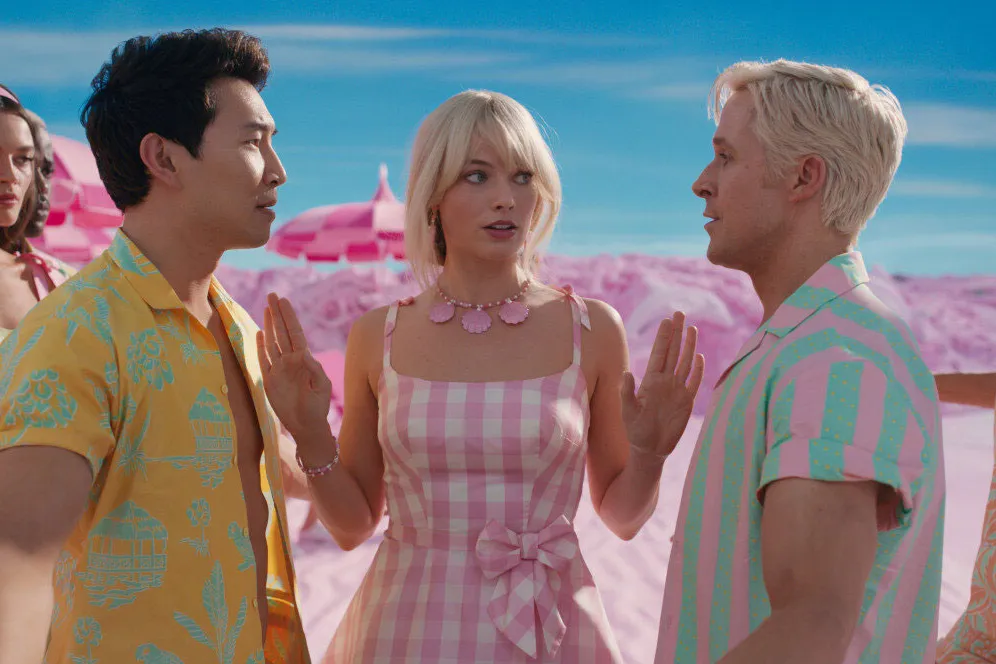Oscar nominations were released last Tuesday, and to many people’s surprise, Barbie director Greta Gerwig was not nominated for Best Director. Although we will never know exactly why she was snubbed, it is likely that Barbie being a blockbuster about a toy brand was a contributing factor (similarly, The Lego Movie, which, despite receiving a 96% on Rotten Tomatoes, was not nominated for Best Animated Feature at the 2015 Oscars). And although the movie fills that description, it is also much smarter than that label gives it credit for, and Gerwig is just as deserving of a Best Director nomination as most others this year. In fact, many aspects of Barbie bring into mind great films of the past. So, if you enjoyed Barbie, here are some movies that inspired it, from Greta Gerwig herself.
If you liked… the opening scene: 2001: A Space Odyssey

Barbie opens with a scene that, without proper context, was probably confusing to a lot of the children in the audience. It’s wide shots of deserts set to an operatic tone poem from 1896, and then a giant Barbie doll shows up, and then the children are smashing their baby dolls. Narration from Helen Mirren makes the core idea clear (the evolution of the doll) but the style is still strange. That’s because it’s an homage to Stanley Kubrick’s 1968 film 2001: A Space Odyssey, widely regarded as one of the greatest films of all time.
Barbie paraphrases the first fifteen minutes of 2001, an extended sequence entitled “The Dawn of Man” in which we see monkeys in Africa fighting, hunting, and eventually encountering a large monolith that spurs them to evolve and leads to their first act of violence after discovering that a bone can be used as a weapon. The scene in Barbie, though condensed, functions the same, with a 20-foot-tall Margot Robbie acting as the monolith who spurs the girls to evolve beyond their baby dolls and embrace Barbie.
But besides the in-joke that something as otherworldly as 2001’s monolith has been replaced with a doll, what’s the reason that Greta Gerwig references this scene to start her movie? In 2001, the monolith isn’t just a tool that leads the monkeys to evolve, but also an object of death. It appears to mark that something, or someone, is about to die. Barbie, to a degree, echoes this. The doll has always been controversial in the feminist movement. Thus, this homage uses allusion to create a central question that will be answered by the film: Did Barbie kill feminism?
2001: A Space Odyssey is streaming on Max.
If you liked… the color palette: The Umbrellas of Cherbourg / The Young Girls of Rochefort

The Umbrellas of Cherbourg and The Young Girls of Rochefort were both directed by Jacques Demy, but when it comes to tone, they couldn’t be more different. The Umbrellas of Cherbourg tells the story of two young lovers who are separated when one is drafted into the Algerian war. The Young Girls of Rochefort is about two sisters living in a small French town who both aspire to find their true loves and move to Paris. The Umbrellas of Cherbourg is melancholy, The Young Girls of Rochefort is fanciful. However, they do share one crucial similarity that carries over to Barbie: a vivacious and otherworldly color palette.
Demy’s two films are both about the overwhelming emotions of young people in love, and the way that these movies look is a reflection of how those emotions spill out into the real world. When the characters in Cherbourg feel sad, that sadness is reflected in the physical spaces they exist in. It may be a little obvious to have a sad character inhabit a blue room, but it’s certainly beautiful.
Barbie follows the same rules as Cherbourg and Rochefort. In Barbieland everything is bright and technicolored and shiny, echoing the bright and shiny lives of the Barbies, Kens, and Alan who live there. When Barbie and Ken go to the real world, however, it’s filled with gray concrete and their rainbow skating outfits stand out in contrast to the grays and complexities of the real world. Just like Demy’s movies, the outfits play into the color scheme as well! When we first see Sasha and her friends, the cynics who believe Barbie is fascist, they’re wearing all black. Gloria, an idealist in an office of business-first workers, also gets bright and colorful clothing. It’s a fun and easy way to communicate immediately who a character is and what they believe, and Barbie is in the Demy tradition when using this technique.
The Umbrellas of Cherbourg and The Young Girls of Rochefort are both streaming on Max.
If you liked… the musical numbers: Singin’ in the Rain / An American in Paris

Despite featuring several original songs and dance sequences, Barbie, for the first two-thirds of its runtime, is not a musical. But roughly 80 minutes in, Ryan Gosling breaks into song, and officially entered the zeitgeist with the now-viral “I’m Just Ken.” And although the song itself certainly doesn’t recall the 1950s, the visual style of the song certainly does. “I’m Just Ken” mainly takes place in the technicolor abstract world pictured above. The inspirations for this were likely two scenes from classic Hollywood musicals: the Broadway melody ballet from Singin’ in the Rain and the closing ballet of An American in Paris, both of which star Gene Kelly. The two sequences are at the climaxes of their respective films, and don’t pertain much to the plot. Instead, they are summaries of the film as a whole, mainly a physical manifestation of the interior conflict of Kelly’s character. This is carried over to “I’m Just Ken,” a maximalist power ballad meant to represent the opposing forces of masculinity waging war in Ken’s mind. In the modern era of filmmaking, it’s quite out of place, but the homage to these two classic films is effective.
Singin’ in the Rain is streaming on Max, An American in Paris is streaming on Amazon Prime Video.
If you like… thinking about dying: A Matter of Life and Death

One of the major moments in Barbie is when Margot Robbie’s Barbie interrupts an extravagant dance party with one simple question: “Do you guys ever think about dying?” It’s the record scratch that takes us out of the pure fun and festivities of Barbieland and into Barbie’s journey to the real world. Through the rest of the film, Barbie continues to deal with complicated feelings surrounding her developing emotions and growing complexity as a person. Her arc mirrors that of the main character of A Matter of Life and Death, Peter Carter. Carter is a British pilot who, as we first meet him, has cheerfully resigned himself to his impending death by plane crash. As he falls from the sky, he talks to an American radio operator, June, and forms a connection with her. Somehow, he manages to survive, and the two fall in love, but an angel from the afterlife comes to collect Carter and he is forced to fight for his survival. Admittedly, it’s a complicated premise, but the movie itself is one of the most beautiful and emotionally cognisant films you’ll ever watch. Similar to Barbie, Carter encounters death and has to deal with evolving feelings and deciding if living is worthwhile. While it may be strange to include a 1947 British war romance on a list of comparisons to Barbie, both films deal with similar ideas, proving that A Matter of Life and Death is as relevant today as it was over 75 years ago.
A Matter of Life and Death is streaming on Tubi.
If you liked… the ending: The Truman Show

The Truman Show was released over 25 years before Barbie, but it speaks to how well the film has aged that its themes are present and relevant as ever in a 2023 film. At the end of both movies (spoilers ahead!) the main characters are attempting to break out of their controlled, pre-ordained worlds and are confronted by the people who put them there. For Truman Burbank, it’s the egotistical producer of the titular show, Cristof, who appears to him from the sky and asks him to stay. For Barbie, it’s the CEO of Mattel, played by Will Ferrell, who rollerblades in with an army of lackeys to stop Barbie from radically changing Barbieland. The crucial part of both of these films, however, is that both characters are given the choice about whether or not they will leave. Both characters choose correctly. Truman lives up to his name, escapes his TV existence and becomes a “True Man.” Barbie, with some help from Barbie inventor Ruth Handler, chooses to become a real human and gives herself real agency. To paraphrase the song that pairs with the scene, Billie Eilish’s “What Was I Made For,” she may not know how to feel, but she wants to try. Both movies thus effectively conclude with a message about self-autonomy and escaping those who want to take that away. What’s the meaning of life? Living it yourself.
The Truman Show is streaming on Paramount Plus.
It’s rare to see a film, especially one this commercial, that cares as much about the history of the medium as Barbie. So, if you liked Barbie, please consider seeing these films. Not only are they excellent in and of themselves, watching them can give a greater understanding of contemporary films like Barbie.




